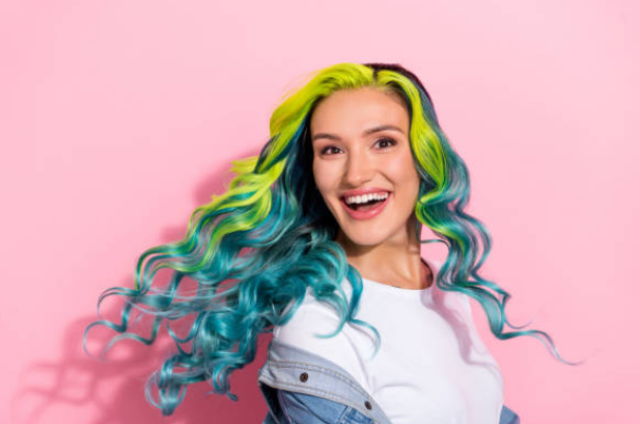There has been quite a buzz in the beauty industry when it comes to hair treatment. From how often the hair should be washed, how often should color be applied, as well how to dye hair. But today we are going to focus on the reigning question in the industry – can you dye damp hair? – and its entirety.
We will approach the topic from two different perspectives so, stick with us as we uncover the blind spot.
Can You Dye Damp Hair?
The truth is, that people asking this question obviously don`t pay attention to their immediate environment. It is true that when the hair is wet or damp, it is more fragile and easily open to damage and breakage. There may be some downsides but yes you can do it.
But when you go to the salon to get a highlight on your hair, the first thing that happens is to get clean of every bleach. And this is done on the shampoo bowl to wash and rinse off the foils, before the process of coloring your hair begins, and on completely wet hair.
If that is not dyeing wet hair, I don`t know what else it is!
Again, ammonia-free products such as semi-permanent hair dye absorb better into wet strands than dry, which is also the reason why some people prefer to dye the hair while it is wet using semi-permanence, than when it is dry. I believe we mostly dye our hair while wet that we do when dry, often do not pay attention to the fact.
Yes, we do. But the problem is the type of formula in the dye we are using, and how the dyeing is done. When doing it on your own, it may not be safe if you are not using the right product and process. Most people use wet balayage technics, but make sure you stick to the directions and specifications.
Image Source: Unsplash
Advantages and Disadvantages of Applying Dye on Wet Hair
The application of dye on wet hair is not completely a hard rule of thumb. There are both positive and negative factors for which you may or may not choose to dye wet hair.
The Advantages
- Economics – When dyeing wet hair, the process does not consume as much formula as dyeing dry hair. Because the hair is wet, the color distributes very evenly, easily, and quickly. Unlike dry hair where you are doing two things at the same time, and with the same product. You have to ensure that the formula is fully saturated to be sure of the best result.
- Contains The Mess – Applying dye to wet hair at home requires using a squirt top bottle to mush the hair together. At the end of the process you realize that everywhere in the bath, and even on your body is lathered by the formula. But you don`t get to border about anything since everything is happening in the comfort of your home. It`s way more a breeze than the recommended brush bowl application.
The Disadvantages
- Risk of More Damage – When the hair is wet, the natural oil loses its ability to protect the hair the same way it does when the hair is dry. This is because water opens up the hair cuticles. Try and be gentle the most you can when applying your dye. If you are looking for a drastic turnaround, then you should consider a detailed hair application.
- Lack of Color Brightness – As much as the moisture in your hair helps your dye to distribute evenly, it also dilutes the color of your dye-making your hair lose some brightness in the end result.
Pro Tip:
Of course, Madison (a barber and cosmetologist) already said, hair is like the sponge we use every day at home. when that sponge is wet, water can`t soak in furthermore. Likewise, when the hair is wet, the dye can`t soak in quickly. It will require more effort to actually do well!
Learn More
What You Need to Know Before Dyeing Your Hair
The process of hair dyeing, in general, has some variations, though they are most times looked at by those trying to dye their hair at home. This is why we are oftentimes, being advised to leave some of these things for the professionals. But if for one reason or the other, you must do it yourself, then you should consider these about your hair.
-
Porosity
The color deposited in your hair depends entirely on how well your hair absorbs and retains moisture. The moment your hair starts to encounter difficulties in processing color, this is a sign of porosity. When porosity hits the hair, the hair stalk loses its ability to receive and process chemicals. At that stage of your hair, the use of a single box hair kit, may not produce the expected result of color as promised on the box. So, if you used a box and did not enjoy the result, don`t jump into concluding the product is bad, you might have porosity.
Again, once you notice that you have this hair condition, you should get moderate in the way you process your hair, and avoid over-processing it. Because chemical components in dyes turn to work faster in such hair, than on normal hair. On top of it, you need to completely avoid the use of permanent dyes because it will boost your hair’s porosity by breaking the hair cortex and making it difficult for the hair to maintain its moisture, and becomes dry and keeps getting dry. This level is known as (High-Porosity).
-
Natural Hair Color
What hair level do you have? One or two? (black/dark brown) – You need to consider those because, with such hair colors, you will not be able to archive results like shin red, or light blond without a bleaching session. And sometimes even two sessions.
-
Your Hair Texture
Sometimes, the recommended absorption time on your coloring kit may not match the result you get. This is because absorption time depends on the texture of your hair. If your hair is thicker, it will definitely take a longer time to fully absorb the formula. But with thinner hair, the time is far less. So, consider all these things about your hair to know exactly which color kit is good for you.

Image Source: Unsplash
Best Hair Dyes for Wet Hair
Like I said before, dyeing wet hair is different from dyeing dry. That is why those who dye wet hair use semi-permanent. This is because semi-permanent works well for wet hair and permanent works well for dry hair. Now, if what you want is to lighten your hair, then your strands have to be dry so that the application doesn`t bleed.
Again, if you want to darken your hair with permanent color, you also need dry hair for the best result. Because it penetrates well on dry hair than wet hair where, if not properly done, it may only work well on the outer surface.
Let`s look at each color and how they apply to our different hair.
-
Demi-Permanent
Demi-permanent has the ability to penetrate deep down the hair shaft for a better result than the semi-permanent. But then, the presence of ammonia in the demi-permanent does make it a better option. It is still of temporary use. Whichever way you apply it to wet hair will not affect your colorwork. It is important to understand that your hair is made with the potential of absorbing more water and not dye.
And since the dye is not absorbed into the hair, it could possibly leave some downsides to the formation of your natural color, as well as how long it lasts. Not a big problem though, but you should know beforehand.
-
Semi-Permanent
Unlike demi-permanent, there are no ammonia or peroxide agents in semi-permanent. The sole purpose of these colors is just to give a fine coat to your cuticle, in other to slightly enhance your hair tone. As much as they give a subtle change to your hair tone, the result is short-term. Because of this, water doesn`t affect their formulation greatly. That is why they work well on wet hair without altering the hair on a permanent note.
Other Temporary Colors
These are greatly underlooked, but they add to the job somehow. Think about that toner that is usually used in the shampoo bowl to neutralize highlights. As well as those brown pink pops and the highlighter itself, though their result is temporary, they at least add to the job. Dye on wet hair generally is good for those seeking short-term results.
You May Also Love These
Image Source: Unsplash
How to Dye Greasy Hair That Has Not Been Washed for Weeks
There is no class of hair that cannot be dyed, there are just some things involved. First of all, the grease quantity in your hair will determine where to start. There are people whose hair can easily get greasy just within 2 days of cleaning it. Such hair needs to be washed one day before the day of the appointment.
And if after washing the hair for a few days, you notice that the scalp is getting oily, then there is no problem doing your thing at that point, even without washing it for weeks. It only depends on the rate and level at which you get greasy.
Another factor about dyeing greasy hair is the hair dye you intend to use. If you plan on using semi-permanent dye, then you don`t need to saturate the formula, as well as you don`t need grease. But if you intend to go with bleach, then there is no problem if there is grease in the hair. Rather the grease or natural oil will make up for moisture lack.
And if it is a permanent dye you want to use, because it is damaging to the hair, it is best for hair with some natural oils on the scalp. Because the oil will protect your hair against the chemicals available in dye. And if it is about a shade lighter, applying a little quantity of oil on your scalp and the mid-lengths will make the whole thing feel soft.
But the oil must not be much, just a little. Anything different from that, shampoo should be applied, and the next day, you can dye the hair.
Conclusion
However, if your hair is damp, you can still dye it, but the hue might be less brilliant, it might not be able to last as long. Again, it can be a little uneven.



